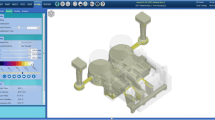Abstract
Computer-based process modeling has long been used for simulating the casting of metals. The information from these simulations has allowed metalcasters to reduce the occurrence of some defects that result from the metal’s volumetric contraction or entrainment of gasses while filling of the mold cavity. The majority of the analysis of the casting process has been limited to the metallic casting itself rather than the mold that contains the metal. High-temperature characterization of molding materials has yielded an increased understanding of the condition of the mold and core during solidification. Properties such as thermal expansion, high-temperature reactions, and changes in surface viscosity and decomposition gasses have yielded an increased understanding of the casting process. By using actual high-temperature mechanical property data generated at the foundry, the accuracy of the solidification modeling is improved and the range of capabilities is increased. The use of applied programming interface code can extend the software’s capabilities and yield additional information on the condition of the mold before, during and after solidification. Although once limited in release, new versions of the process modeling software will include the capability to both optimize process variables and develop material-specific datasets that increase both the accuracy and extend the capabilities of the analysis. Using applied programming interface code, the range of capabilities of the process modeling software can be extended to include information on veining defects, final casting dimensions and decomposition gas generation that can result in porosity defects or changes to the thermal properties of the mold.




























Similar content being viewed by others
References
International Atlas of Casting Defects, American Foundry Society, 1993
J. Thiel, C. Monroe, High temperature physical properties of chemically bonded sands and what to do with them. in 2009 SFSA Technical and Operating Conference Proceedings
J. Thiel, S. Ravi, Causes and solutions to veining defects in iron and steel castings, in AFS Proceedings 2014, Paper 14-030
J. Thiel, High temperature physical properties of chemically bonded sands provide insight into core distortion. AFS Trans. 117(Paper 09-067), 323–339 (2009)
G. Tardos, D. Mazzone, R. Pfeffer, Measurement of surface viscosities using a dilatometer. Can. J. Chem. Eng. 62, 884–888 (1984)
R.L. Naro, Variables affecting the formation of porosity defects in grey iron castings prepared with urethane binder systems. AFS Trans. 82, 257 (1974)
W.L. Tordoff, R.D. Tenaglia, Test casting evaluation of chemical binder systems. AFS Trans. 88, 149–158 (1980)
G.J. Samuels, C. Beckermann, Measurement of Gas Evolution from PUNB Bonded Sand as a Function of Temperature. University of Iowa
Acknowledgments
The authors wish to acknowledge the efforts of the student employees of the University of Northern Iowa Metal Casting Center for their assistance in the experiments required in the research. The authors would also like to acknowledge the contribution of Dr. Charles Monroe of the University of Alabama for the original development of the API code used to evaluate the vein strain cited in this paper. The authors also recognize Shelley Dutler and Magma Foundry Software for the use of the simulation software and technical assistance in its operation.
Author information
Authors and Affiliations
Corresponding author
Rights and permissions
About this article
Cite this article
Ravi, S., Thiel, J. Increasing the Capabilities of Computer Process Modeling with Applied Programming Interface. Inter Metalcast 11, 101–115 (2017). https://doi.org/10.1007/s40962-016-0104-9
Published:
Issue Date:
DOI: https://doi.org/10.1007/s40962-016-0104-9




